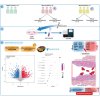Chandelier
Senior Member (Voting Rights)
Paula Poyatos 1 2 , Miquel Gratacós 1 , Daniel Aguilar 3 , Neus Luque 1 , Marc Bonnin-Vilaplana 2 4 5 , Saioa Eizaguirre 2 4 , Marta Cascante 6 7 8 , Ramon Orriols 2 4 5 9 , Olga Tura-Ceide 1 2 3 4 9
Highlights
- Transcriptomic profiling reveals long-term endothelial dysfunction in post-COVID-19
- Enrichment analyses highlight disrupted pathways of endothelial homeostasis
- Minimal changes between 3 and 6 months suggest sustained endothelial damage
- Post-COVID patients with PE display unique profiles with reduced thrombosis markers
SUMMARY
Severe Acute Respiratory Syndrome Coronavirus 2 (SARS-CoV-2) has caused significant global morbidity since 2019.Long-COVID, characterized by persistent symptoms after acute infection, may involve endothelial injury.
We analyzed endothelial colony-forming cells (ECFCs) from post-COVID-19 patients at 3- and 6-months post-infection, comparing them with healthy controls and stratifying by prior pulmonary embolism (PE).
Transcriptomic profiling identified differentially expressed genes (DEGs) associated with endothelial homeostasis, inflammation, oxidative stress, and thrombosis.
Post-COVID ECFCs showed downregulation of NOS3, KLF2, ANGPT1, PIK3R3, GBX2, GDF6, SMAD6, SRC, and TGFB1, and upregulation of CASP1, CXCL5, IL12A, SOD2, TIMP3, and TLR2.
Minimal differences were observed between 3 and 6-month samples. PE patients showed downregulation of thrombosis-related genes such as PTGS2 and ACKR3.
These findings indicate sustained endothelial dysfunction and inflammation up to 6 months post-infection, highlighting the importance of long-term monitoring and potential therapeutic strategies to support vascular health in post-COVID-19 patients.


